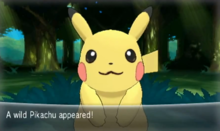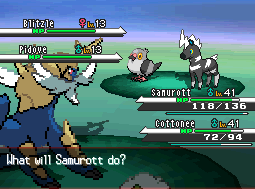Wild Pokémon

|
This article is incomplete. Please feel free to edit this article to add missing information and complete it. Reason: Missing side games/spinoffs |
Wild Pokémon (Japanese: 野生ポケモン wild Pokémon) are any Pokémon that are not currently owned by a Pokémon Trainer. They are encountered in most parts of the Pokémon world, most commonly outside of cities and towns, often in tall grass, in caves, or on water. A Trainer may choose to battle a wild Pokémon or run from it. If a Trainer chooses to battle, they may either attempt to catch the Pokémon with a Poké Ball or to defeat it outright. There are many instances of wild Pokémon being used for assistance without being caught, such as Pokémon Rangers using them to perform a task by directing them with a Capture Styler.
In the games
In the core series

|
This section is incomplete. Please feel free to edit this section to add missing information and complete it. Reason: encounter chances in newer games |
Generation I
Since Generation I, wild Pokémon will appear to the player in a variety of locations, most often when the player is walking through or near tall grass. Other methods of encountering wild Pokémon include walking through caves or abandoned buildings, fishing, surfing on water, and interacting with Pokémon in the overworld. The species and level of the Pokémon both depend on both the location and encounter method.
Each tile has a number that affects the chance of finding a wild Pokémon. Tall grass varies from 15 to 25 (except the Safari Zone, which has 30), caves vary from 10 to 15 (except Mewtwo's room in Cerulean Cave, which has 25), and all water tiles use the number 5. Each time the player takes a step in a tile with wild Pokémon, the game generates a random number from 0 to 255 (inclusive). If that random number is less than the tile's encounter number, the game generates a species and level. Repels prevent encounters with any Pokémon of a lower level than the party's first Pokémon.
When encountered, a wild Pokémon's moveset will generally consist of the most recent four moves its species would know by leveling-up; for example, a level 4 Nidoran♂ will know Leer and Tackle when encountered in the wild in Red and Blue, while one encountered at level 22 will know Tackle, Horn Attack, Poison Sting, and Focus Energy.
At the beginning of every turn, wild Pokémon have an equal chance of selecting each move that they can use. If all the Pokémon in the player's party faint while battling a wild Pokémon, the player will drop some money in panic.
Generation II
Generation II introduced four encounter methods, namely smashing breakable rocks, headbutting Headbutt trees, using Sweet Scent, and roaming Pokémon. Additionally, the species of wild Pokémon depends on the current time and mass outbreaks.
In this generation, tall grass varies from 15 to 25, and both caves and water have encounter numbers between 5 and 15 (except Diglett's Cave in the daytime, which has 2). Pokémon March and the Ruins of Alph signal, played on the Pokégear, will double the encounter rate, and the Pokémon Lullaby and Cleanse Tag halve the rate. All of these multipliers stack with each other.
Repels prevent encounters with any Pokémon of a lower level than the party's first conscious Pokémon. Wild Pokémon can hold items, which can be obtained by catching the Pokémon or using one of a set of moves, like Thief. Wild Pokémon that use one of those moves can steal the player's Pokémon's held item.
Generation III
Wild Pokémon can appear in deep sand. The random number varies from 0 to 2879. Tall grass has 320 (except Route 119, which has 240, and Safari Zone, which has 400), caves have 160 (except Seafloor Cavern, which has 64, Cave of Origin, which has 64, and Altering Cave, which has 112), and water and seaweed have 64 (except Safari Zone, which has 144).
Bicycles, White Flute, Black Flute, and Cleanse Tag multiply the encounter number by 0.8, 1.5, 0.5, and 0.66, respectively. Additionally, certain Abilities affect wild Pokémon in various ways—many only gaining these effects in Emerald. Unlike Repels, these modifiers ignore whether the first Pokémon in the party is fainted.
Wild Pokémon cannot steal the player's Pokémon's held item regardless of what moves they use.
Generation IV
Honey has the same effect as Sweet Scent in the overworld. However, using Honey on a Honey Tree will attract a Pokémon from a different encounter table. From Generation IV onward, multiple wild Pokémon can appear at once. All but one of the Pokémon will have to be defeated before that one can be caught. In Generation IV, the only way to encounter multiple wild Pokémon at once is walking while accompanied by another Pokémon Trainer.
Generation V
Starting in Generation V, wild Pokémon can appear in puddles or phenomena. There is the chance of two Pokémon appearing at once in dark grass. Two types of Pass Powers (Encounter Power ↑ and Encounter Power ↓ ) modify encounter chances. Wild Pokémon can steal the player's Pokémon's held item.
Generation VI
In Generation VI, wild Pokémon can appear in snow, ambush encounters, and while soaring. Hordes of five Pokémon may appear. Two O-Powers (Encounter Power and Stealth Power) modify encounter chances. Repels prevent encounters with any Pokémon of a lower level than the party's first Pokémon.
Generation VII
In Generation VII, a wild Pokémon can call for an ally, turning the battle into a 2-on-1 scenario. In Ultra Sun and Ultra Moon, encounters can be prevented by Roto Stealth.
Generation VIII
Repels prevent random encounters with any Pokémon of a lower level than the party's first Pokémon. They have no effect on other encounters.
In Pokémon Brilliant Diamond and Shining Pearl, the camera view might show the player before the wild Pokémon. In that case, the wild Pokémon has two or more IVs of 31.
Encounter messages

|
This section is incomplete. Please feel free to edit this section to add missing information and complete it. Reason: Any missing variants of the message |
There are times when the usual A wild <Pokémon> appeared! will be replaced by another message:
| Game | Situation | Message |
|---|---|---|
| All Generation I and II games | when a wild Pokémon is fished out | The hooked <Pokémon> attacked! |
| All Generation II games | when a wild Pokémon is encountered using Headbutt | <Pokémon> fell out of the tree! |
| XD: Gale of Darkness | Pokémon in Battle Bingo | Oh! <Pokémon> appeared! |
| All Generation IV games | wild Double Battle when with a Stat Trainer | A wild <Pokémon> and <Pokémon> appeared! |
| All Generation IV games | encountering a Pokémon in Pal Park | Wow! <Pokémon's OT>'s <Pokémon's nickname> is drawing close! |
| Diamond and Pearl | battle against Starly immediately after picking the starter Pokémon | Whoa! A wild <Pokémon> came charging! |
| Diamond, Pearl, and Platinum | when checking out a shaking Honey Tree | A wild <Pokémon> appeared from the tree you slathered with Honey! |
| Platinum | battle against Giratina in the Distortion World | The Distortion World's <Pokémon> appeared! |
| All Generation V games | wild Double Battle initiated by dark grass or with a partner NPC | Oh! A wild <Pokémon> and <Pokémon> appeared! |
| All Generation V, VI, VII, and VIII games | battle against a non-roaming Legendary or Mythical Pokémon, Volcarona in Relic Castle, disguised Zoroark in Lostlorn Forest, an Ultra Beast that is registered in the Pokédex, or Max Raid Battle Pokémon | <Pokémon> appeared! |
| Black 2 and White 2 | encountering one of N's Pokémon | A wild <Pokémon> appeared?! |
| X and Y | Routes 9 and 17 | Whoa! The <Pokémon> you stepped on attacked! |
| X and Y | walking into a shadow in caves | Whoa! A wild <Pokémon> swooped down from above! |
| X and Y | walking into a shadow next to a tree in the outdoor part of Victory Road | Whoa! A wild <Pokémon> dived out of the sky! |
| X and Y | encountering a Pokémon by interacting with a trash can | Whoa! A wild <Pokémon> leaped out of the trash can! |
| X and Y | bushes on Routes 6 and 18 | Whoa! A wild <Pokémon> leaped out of the tall grass! |
| All Generation VI and VII games | during the catching demonstration | Oh! A wild <Pokémon> appeared! |
| X and Y | roaming Articuno, Zapdos or Moltres | Oh! A wild <Pokémon> appeared! |
| All Generation VI games | Horde Encounters | Whoa! A horde of <Pokémon> appeared! |
| Sun, Moon, Ultra Sun, and Ultra Moon | Totem Pokémon | You are challenged by Totem <Pokémon>! |
| Sun, Moon, Ultra Sun, and Ultra Moon | encountering an Ultra Beast (before registering it in the Pokédex) | ??? appeared! |
| Sword and Shield | encountering a Pokémon whose level is too high for the player to catch | You encountered a very strong-looking <Pokémon>! |
| Brilliant Diamond and Shining Pearl | encountering two wild Pokémon of different species | You encountered a wild <Pokémon> and <Pokémon>! |
| Brilliant Diamond and Shining Pearl | encountering two wild Pokémon of the same species | You encountered two wild <Pokémon>! |
In the side games
Pokémon GO
In Pokémon GO, wild Pokémon appear on a map of the real world (based on the crowdsourced OpenStreetMap project)[1][2], with the player moving in the game by traveling in the real world. When a Pokémon is nearby, the player's phone vibrates. The player can encounter a nearby Pokémon by tapping it in the Map View. Different kinds of Pokémon will appear in different environments; for example, Water-type Pokémon are more common near water. Weather also affects which Pokémon are common.
In a wild encounter, the player attempts to catch a wild Pokémon in a Poké Ball before it runs away. Unlike in the core series games, these encounters do not involve battle. At higher levels, the player can use various Berries to make wild Pokémon easier to catch or use more powerful Poké Balls like Great Balls and Ultra Balls. While pressing and holding a Poké Ball, a ring will appear around the Pokémon. This ring shrinks over time; once it reaches its smallest size, it immediately returns to full size, and the cycle repeats. If the Poké Ball is thrown while the ring is very small, the capture is more likely to be successful. Throwing the ball while the ring is as far out as it can be, or halfway in the outer circle also provides small bonuses.
Encounter messages
There are times when the usual A wild <Pokémon> appeared! will be replaced by another message: encountering a defeated Raid Boss or a Shadow Pokémon will yield this message: Bonus Challenge! Catch <Pokémon>!
In the anime

Typically, wild Pokémon are not a central feature of the anime, which focuses mostly on the Pokémon belonging to Ash, his friends, and other Trainers that he encounters. Most of the Pokémon belonging to the group were shown in the wild at some point, but are usually caught at a later point in the same episode, most often at the end. Despite this, there have been several recurring wild Pokémon who appear over a length of time and are not caught. Of all of these Pokémon, a Caterpie, a Shiny Gyarados, an Aipom, a Gible, a Krokorok, a Froakie, a Dedenne, a Rockruff, a Litten, a Poipole, an Eevee, a Meltan, two Gengar, a Scorbunny, a Sobble, an Eternatus, and a Morpeko all went on to be caught several episodes after they appeared. As demonstrated on a number of occasions, Meowth is also a wild Pokémon.
There are, however, numerous examples of wild Pokémon being featured in the anime in debut episodes that introduce their species, such as Clefairy in Clefairy and the Moon Stone and Sudowoodo in Type Casting.
In the first anime episode, Ash's Pokédex states that wild Pokémon tend to be jealous of human-trained Pokémon, this being one of the reasons that the Spearow Ash hit with a rock attacked Pikachu instead.
Pokédex entries
|
In the manga
Pokémon Adventures
As Pokédexes prior to the arcs in Hoenn typically needed the Pokémon to be captured in order for data to be gained, capturing wild Pokémon has been a long-standing point for every Pokédex Holder save Gold and Silver until the Ruby & Sapphire arc. The first wild Pokémon to be captured was a wild Nidorino by Red, and even legendary Pokémon were seen as soon as the first round, though the one in question (a Mew appearing near Pallet Town) was not captured. Pokémon that have been released, unlike in the games, do sometimes appear in the wild and can be re-caught or controlled by another Trainer, such as Emerald's Sceptile and Mewtwo, and again unlike in the games, where identical Trainer ID means that high-level Pokémon can be controlled by its Trainer, several Pokémon such as Pika and Zeller were disobedient and likely to even attack its Trainer on a whim.
Trivia
- In early versions of Pokémon Red and Green, the wild encounter rate was so high that players would encounter wild Pokémon every two steps. Combined with the fact that Trainers would battle the player every time the player walked past them regardless of whether they had already been defeated, it would take players half a day to get through a single cave. Game Freak adjusted the wild encounter rate and changed Trainer battles for a more reasonable experience before the game was released.[3]
In other languages
| |||||||||||||||||||||||||||||||||||||||||||||||||||||||


